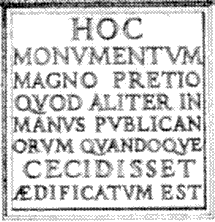Hoc monumentum...
6 February 2001

The English architect Quinlan Terry is a remarkable classicist, a throwback to a mode of architecture that all but disappeared some generations ago. He has said I don’t think we can ignore the Modern Movement. But I wouldn't have minded at all if it hadn't happened. I think the world would be a much nicer place.
Terry knows his architecture well enough (and his Latin) to crack a joke with a column and an inscription. I’ll let Clive Aslet tell the story of one of Quinlan Terry’s designs in the gardens of West Green House in Hampshire:
At West Green, the first of the follies announces itself before you turn down the present drive to the house. For a great column and finial of Portland stone have been placed near the road, at the end of a new lime avenue on axis with the entrance front of the house. A new drive along this avenue is being formed. But the placing of the column so near the public road could with justice be called provocative. The column, however handsome, is quite deliberately and flagrantly useless, and makes no concessions on this point to mealy-mouthed notions of economy, modesty and reserve. It was conceived at the time when the Labour government was threatening to bring in a wealth tax. Lord McAlpine, who belongs to the McAlpine construction family and is Treasurer of the Conservative Party, expressed his feelings in architecture, Terry devising the legend: ‘Hoc monumentum magno pretio quod aliter in manus publicanorum quandoquc cecidisset aedifteaturn est’ (‘This monument was built with a large sum of money, which would have otherwise fallen, sooner or later, into the hands of the tax-gatherers’). Terry's first design, dated July 1975, shows a column with rubble rustication and a Portland stone finial, surrounded by a thatched hut at the base. It is similar to Erith and Terry's croquet pavilion at Aynho. By November 1975 he was proposing a straight column with vermiculated bands and a flaming urn. This developed into what we see now: a column with bands of rustication which are themselves banded, like the Michelin Man’s tyres, and with a bold and bulbous finial on top. Alas, the triumphal arch with obelisks which Lord McAlpine proposed erecting in honour of the first lady prime minister of Great Britain in 1979 was designed but never built.
[Clive Aslet, Quinlan Terry: the revival of architecture (Harmondsworth: Penguin, 1986), page 121.]
